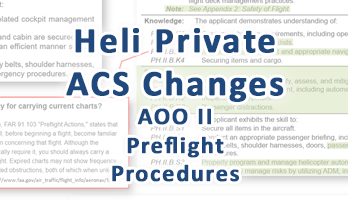This is the twenty third training flight in a series following a student through his flight training from day 1 to checkride in an R22.
Due to flying with one door off, the airflow creates some extra noise, which means some interference in the audio in some parts of the video.
This is the student’s 2nd cross country flight, combined with some emergency procedure training. Some highlights of this lesson:
- Demonstration of reduction of power due to magneto failure
- Cross country flying tips
- Filing and updating flight plans
- VFR traffic advisories (flight following)
- Governor off takeoff
- Clutch warning light procedure
- 1st 180 autorotation to the flare
Below the video are time-stamped notes/tips for the flight.
NOTES/TIPS:
00:05 demonstration/simulation of reduction of available power when a magneto fails (on the ground only!!)
04:40 using squelch to little to a weak broken signal
09:20 use airport diagram on kneeboard, compass, hands etc to work out entry into pattern with crossing runways
13:30 don’t blindly reach down and pull things – it might be your fuel mixture!
16:40 use a distant reference to help hold track/heading
18:20 at night use roads more and less direct for safety
21:25 be mindful of options in the event of engine failure and glide distance
33:40 always be looking for traffic not using/without radios
35:40 hover over hard surface rather than grass for better performance (and reduce dust)
39:23 departing Madras after stop for fuel
41:45 using the MAP limit chart to get an estimate between 4 values
44:45 dashed single yellow line = taxiway hold short lines
48:00 using solely pilotage to navigate
51:00 progress report and updated ETA to VFR flight plan with FSS
52:00 good example of the phrase ‘break’ to separate two different radio calls on one transmission
52:35 reporting wildfires
54:00 VFR traffic advisories (flight following) from Seattle Center
57:40 VFR altitude rules above 3000′ AGL
58:50 simulated engine failure
1:03:45 how DA affects indicated airspeed, versus GPS ground speed
1:04:40 right of way rules
1:06:30 remain well clear of wildfire operations and ask ATC if you suspect a Temporary Flight Restriction (TFR) to be in affect
1:10:15 simulated governor malfunction and low RPM recovery
1:15:20 small private airstrips often don’t make good waypoints as they are hard to spot until right over them
1:17:00 minimum altitude regulations
1:17:30 estimating power off glide distance
1:18:45 simulated engine failure – announce target area
1:30:30 displaced threshold markings
1:31:15 governor off takeoff – can consume your attention
1:35:50 using ‘hand rails’ like cuttings in trees for navigation and safety
1:38:20 clutch warning light emergency procedure
1:38:50 avoid long-winded radio calls – multiple examples from Malibu
1:43:25 when looking for traffic, look in the opposite spots too – people make mistakes
1:45:00 first 180 degree autorotation to runway, talking about additional 200′ check
1:46:45 start with simple and knows first (straight in auto) and then add the new, more complex (180 degree turn)
1:48:55 don’t use the phrase “any traffic please advise” – for a bunch of reasons
1:50:10 airplane trying takeoff as we autorotate to the same runway
1:54:20 another straight in autorotation (adjust cyclic to compensate for collective pitch change)
1:56:40 hover autorotations
To view all the videos in this series, check out this YouTube playlist of all the Flight Training Sessions (Full-Length Unedited)






My most sincere gratitude to all your team. For all that mountain of information provided, which has make it a lot easier and more productive on all of my training. God blessed you for providing it free of charge. I am sure that your generosity, have made possible the dream of becoming a helicopter pilot for many more persons, which otherwise would not have been able to afford the full training cost. Thank you!!!